Dzogchen Ponlop Rinpoche Book ‘Emotional Rescue’
Offers Real Solutions to Emotional Tangles
Written by: Diane Brooks
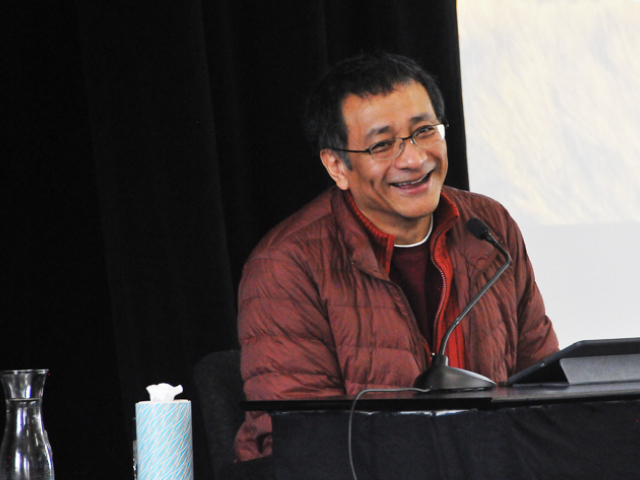
Ponlop Rinpoche laughs as he teaches on his new book, “Emotional Rescue,” during a recent weekend event at Nalanda West in Seattle.
Photos by: Rysiek Frackiewicz , Nirzhar Pradhan
Dzogchen Ponlop Rinpoche’s newest book, “Emotional Rescue: How to Work with Your Emotions to Transform Hurt and Confusion into Energy that Empowers You,” is a self-help guide for a broad audience.
Unlike his previous books, such as “Mind Beyond Death” or “Rebel Buddha,” this one is written for a more Western readership, with little direct reference to Buddhist teachings or concepts.
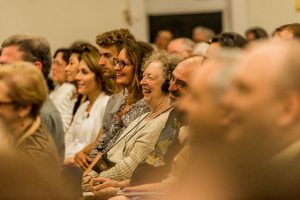
People were rapt, and amused, during the weekend teachings in Seattle.
When Dzogchen Ponlop Rinpoche speaks or writes about emotional pain and confusion, he doesn’t set himself up on a teacher’s superior pedestal. The roller coaster of emotions is universal, without religious or secular boundaries, so he includes lightly-humorous stories about himself, making it clear he is not immune.
“My challenges set me on a journey to understand the power of our emotions – the power to create happiness or suffering,” he said at a May 20-22 book teaching at Seattle’s Nalanda West, the headquarters of his international Nalandabodhi organization.
The Seattle event was Ponlop Rinpoche’s final stop on a book tour that began April 4 in Philadelphia at Temple University, and included teachings in Halifax, N.S.; Washington D.C.; and New York City. Organizers reached out to universities, therapists, educators, yoga communities, and health and well-being groups, in addition to Buddhist audiences.
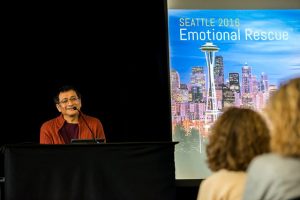
Ponlop Rinpoche’s “Emotional Rescue” teachings were illustrated with an often-amusing series of projected images.
“Just think what our life would be like without any emotions. Pretty boring, right?” he said to the Seattle audience. “Emotions are like the fizz in the soda. Who wants a flat soda? Nobody enjoys flat soda. So who can enjoy life without emotions? … [Emotion] kind of sparkles our life, and brings us fizz in our life. Without the emotions, our life would be pretty flat.”
But some emotions – anger, jealousy, passion — can cause heartbreak. So Ponlop Rinpoche has crafted a three-step “emotional rescue” plan to help us recognize and transform our habitual emotional patterns. The goal is learning to recognize how our thoughts, labels and story-spinning can pollute our emotional energy, so we instead can tap into its innate creative and healing powers.
The book’s genesis was a seminal teaching on emotions that Ponlop Rinpoche gave in 2006 at the 15th Annual Treasury of Knowledge Retreat in San Antonio, Texas. He expanded on that teaching during subsequent events, including a talk at Tibet House in New York.
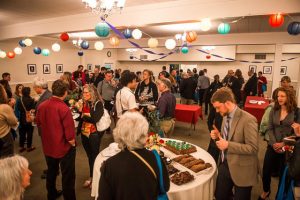
Ponlop Rinpoche’s secretary Ben Mikolaj, bottom right, gives an appreciative thumb’s-up as he checks out the goodies provided by event co-sponsors Compassionate Action Network and the Kirlin Foundation.
“Emotional Refuge” pulls together those original teachings, augmented with fresh material, including an assortment of practical exercises and contemplations spread throughout the book. Some of the exercises were crafted in recent years by Nalandabodhi mitras (senior teachers) as part of the organization’s “path of activity” curriculum, which applies the Tibetan Buddhist teachings to daily life.
Dan Kranzler, co-founder of Seeds of Compassion, participated in the Friday public talk that opened the Seattle teachings. Nearly 400 people attended that talk, while about 175 participated in the full weekend program.
“Ponlop Rinpoche brings the essence of what Buddhism aspires to be – not just as an academic, and not just as a teacher, but as a full human being,” Kranzler said, as he introduced Ponlop Rinpoche to the audience. He marveled at Ponlop Rinpoche’s broad interests and talents: he’s an artist, poet and photographer; he’s tech savvy; and he loves music and pop culture.
“What’s fascinating is how he translates really difficult Buddhist teachings into a secular, easy-to-understand, practical roadmap to understand and address our emotions.”
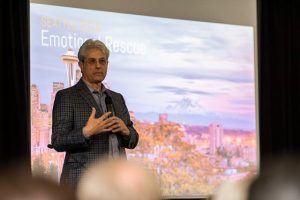
Daniel Kranzler, co-founder of Seeds of Compassion, introduced Ponlop Rinpoche at the Friday night public talk.
The event itself felt more Western than Buddhist. Gone were the floor mats and cushions, replaced with formal rows of chairs. A velvety black curtain completely obscured the marble shrine with its golden statues of Buddha, Guru Rinpoche and Green Tara. Guests at the Friday night public talk were given the rare instruction to not remove their shoes. And a large video screen displayed a colorful and often amusing series of images to illustrate Ponlop Rinpoche’s teaching points.
Both the book and live teachings are rife with Ponlop Rinpoche’s trademark pop-culture references – Facebook, video games, reality T.V., Dr. Doom. Even the book’s title brings a knowing smile to students who are familiar with his fondness for the Rolling Stones. (For the record: he doesn’t care much for the Stones’ hit 1980 disco-flavored album, “Emotional Rescue.”)
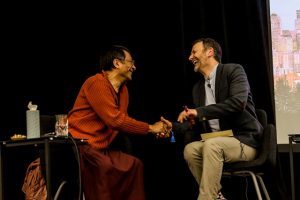
Ponlop Rinpoche and Brad Lichtenstein, a Bastyr University professor and a naturopathic physician, shared a Q&A near the end of the Friday night public talk. (Brad asked, Rinpoche answered.)
Rinpoche’s emotional-rescue plan – sometimes called his “E.R.” plan, an analogy for emergency room – occupies the first three-quarters of the book. The final section offers classical Buddhist perspectives, along with two more practical exercises.
The three-step plan, in brief:
- Mindful Gap – This first step has three parts: feel, hold and look. The instant an emotion arises, remember to stop and access a “gap” moment before thoughts kick in. First, just feel the energy; then stay present and relax, without replaying what happened or looking ahead, while watching the energy shift and change; then look nakedly at the experience. Stop the energy from overwhelming you. “Only in this open, nonjudgmental gap, in this space, can you truly acknowledge what you are feeling,” Rinpoche said. “Mindfulness is a way to bring our mind … [away] from our mental chatters and from our mental storylines to this present-moment experience.”
- Clear Seeing – Look at both the emotions and their surrounding landscape, examining the big picture to identify recurring patterns of behavior. Discover personal triggers, and experience the relationship between one’s inner and outer worlds. Reclaim and redirect the emotional energy toward something more positive.“When we look mindfully at those patterns, we begin to see the causes or triggers that can initiate a chain reaction of negative or positive events, and as we practice clear seeing we develop a clear picture of our emotional profile,” he said. “It’s like taking an emotional selfie.”
- Letting Go – This is the opposite of rejecting or repressing emotions. The first two steps allow one to let go of habitual emotional and behavioral reactions. By being attentive and aware, the energy of the initial emotion is unknotted. Relax the senses, body and mind, and recognize the emotion’s creative, vivid energy.“It’s a process of moving forward,” he said. “Working with now, in this moment, then letting go and moving forward.”
During a break in the teachings, Seattle resident Adrienne Cochrane vouched for the power and usefulness of the three-point plan. She learned the techniques when she attended the 2006 Texas retreat, where she first met Ponlop Rinpoche.
“I have such a deep appreciation,” she said. “Two months after retreat, I had a gripping emotional situation where I used mindful gap, and it actually worked. It was so exciting. That’s when I realized, this is really helpful. It helped me deal much more skillfully with a really intense situation that could have escalated.”
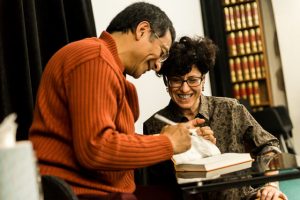
Ponlop Rinpoche signs a book for one of his students, Sarah Plotkin, who traveled from San Francisco to attend the weekend teaching.
Also in attendance was Lara Flynn, of Shoreline, who teaches at the ACES alternative high school in Mukilteo. She won a scholarship to the weekend event from co-sponsor Compassionate Action Network. Her application referenced her school’s recent loss of a student who died in a December gang-related shooting.
“That was one of the most difficult emotional experiences for us collectively to deal with,” she said. “I felt at that time a little bit at a loss to figure out how to help my students process that.”
Flynn added that she’s hoping to create some curriculum, using Rinpoche’s material, which students could practice and work with.
“I’m taking away a great deal of knowledge, in terms of accepting and holding and honoring an emotional experience without needing to push it away or deny it or fix it,” she said.
That’s the sort of response Ponlop Rinpoche hoped his teachings might engender.
“As long as we decide that we want to free ourselves and fulfill our potential for happiness, we have the power to do it,” he said. “Because already it is there. You’re fully equipped with your genuine power and wisdom.”
